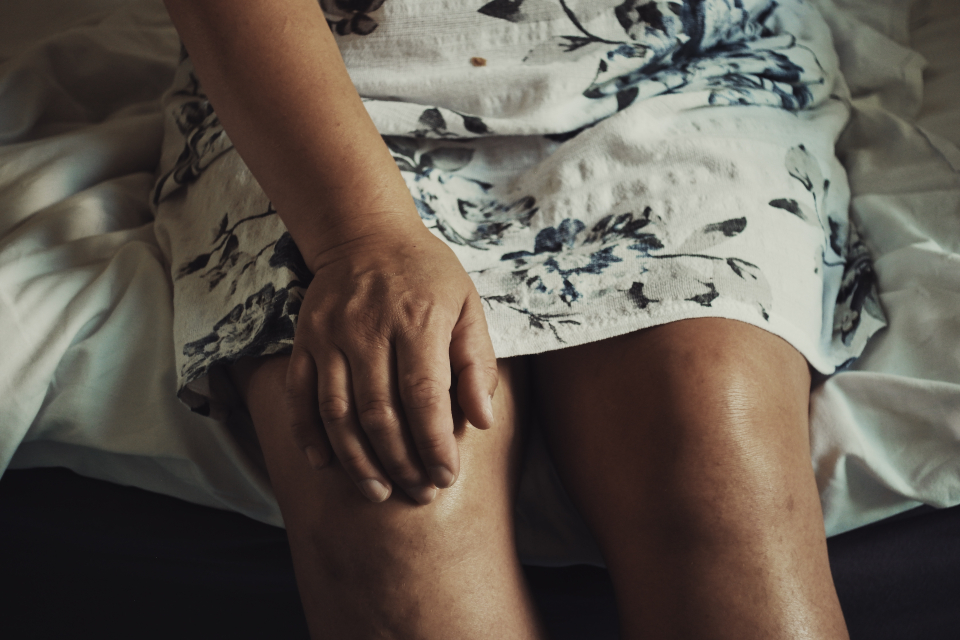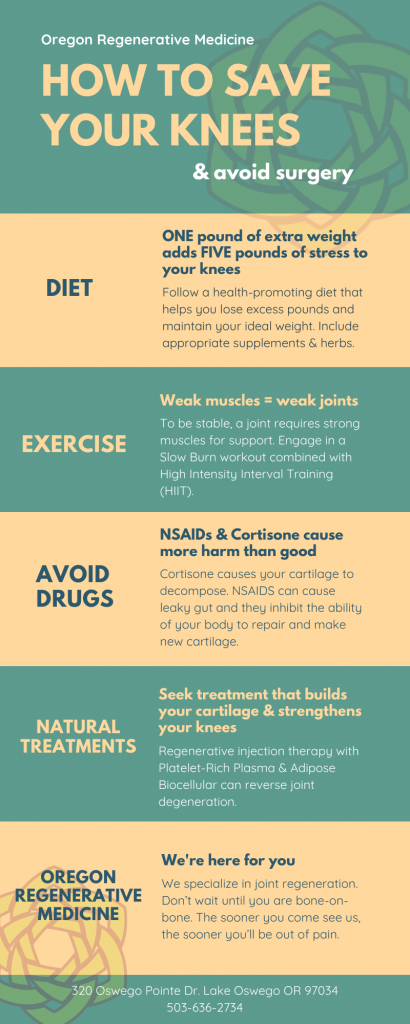by Dr. Noel Peterson, ND, DAAPM
Carl’s x-rays showed he had early-stage, grade 1 or 2 knee osteoarthritis (KOA). He was a 42-year-old accountant who relished his time spent outdoors. He loved his daily walks, skiing, and biking. He kept his fitness up by working out at the gym.
Then he began having pain his right knee. He reduced and allocated how much time he could spend on his feet before the pain would return. Almost every evening his knee would ache.
Carl’s primary care provider recommended over the counter NSAIDs (nonsteroidal anti-inflammatory drugs, ie., ibuprofen, Naproxin). Taking Advil did control the pain, but then he learned about the proven negative side-effects of NSAIDs.

NSAIDS can cause leaky gut by breaking holes in the intestinal wall. This results in nutrient mal-absorption, disruption of the gut biome, and joint inflammation. Worse yet, NSAIDS actually inhibit the ability of the body to repair and make new cartilage. It made zero sense for Carl to take a pain medication that actually worsened his arthritis.
Carl’s visit to Oregon Regenerative Medicine
The good news was that Carl’s knee osteoarthritis was diagnosed relatively early. Most of the patients we see have been ignoring (or medicating) their knee pain for years. Most were told that eventually, once the pain becomes intolerable, the surgeon could give them a “new knee”.
With Carl’s early diagnosis, he would almost certainly be able to restore the function of his knee with platelet-rich plasma (PRP) or adipose biocellular therapy. Combined with appropriate exercise, his KOA should not worsen to the point that he would even need a knee replacement.
About knee osteoarthritis
Knee osteoarthritis is the most common form of large joint arthritis. Mild pain is typically the symptom that prompts people to visit their health care providers. There are substantial downsides to living with KOA, including pain with exercise, reduced mobility and quality of life.

Trends from 1990 to 2016 show, that of the top 20 contributors, osteoarthritis (OA) is ranked as the second most rapidly rising condition associated with disability. OA has had a 46 percent increase in years lost to disability, just behind diabetes at 52 percent. With the aging population and higher rates of obesity, this burden will continue to rise.
This rapid increase in the prevalence of OA will lead to a growing impact and major challenges for health care and public health systems. The medical device giants are well aware of this.
Effective, proven, non-surgical treatments for knee pain such as Prolotherapy and Platelet Rich Plasma PRP are falsely referred to as “experimental”. Meanwhile, multiple billions are spent advertising harmful drugs that actually lead to surgery. Ads feature the sweet smiles of “arthritic” actors (they all look pretty healthy to me). They’re shown free of pain, practicing Tai Chi in the park and playing ball with their grandchildren. They’ve been completely “restored” by NSAIDs and surgery.
Oregon Regenerative Medicine’s approach to KOA
Because Carl’s KOA was only Stage 1-2, our experience indicated that he would have an over 90% improvement and response to treatment. His program included:
- A series of platelet-rich plasma treatments
- A gradual transition to a Slow Burn strength training routine
- Transforming his walking routine into a HIIT (high-intensity interval training) workout
- An anti-inflammatory diet
- Highly absorbable nutritional and herbal supplements
The power of regenerative injection therapy
By 6-months, Carl’s knee was symptom-free, and his overall strength had measurably improved. By his 43rd birthday, Carl was naturally improving his knee cartilage and helping the rest of his joints become healthier as well.
What can you do to avoid drugs and surgery for arthritis?
Your blueprint for saving your knees and avoiding surgery:
- Follow a health-promoting diet. Lose any excess pounds and maintain your ideal weight. Every pound of extra weight adds 5 pounds of stress to your knees.
- Get regular exercise. Weak muscles = weak joints. To be stable, a joint requires strong muscles for support. When muscles are weak the joint is lax and moves in a sloppy manner. This increases friction and wear much like the way a sloppy wheel bearing overheats and wears out. When the muscles support the joint, it glides smoothly and cleanly.
- Avoid NSAID drugs like the plague, and NEVER let anyone inject cortisone into your hips or knees. Cortisone causes your cartilage to literally decompose. The medical term for the effect of steroid injections in the knee or hip is subchondral osteonecrosis. And believe me, any drug that causes a condition with necrosis in it is bad news.
- Seek regenerative treatments that have been shown to help your cartilage repair and strengthen your knees.
We’re here for you
Let us help you vanquish pain and recover function with our cost-effective osteoarthritis protocol which includes specific nutrition, focused exercises, physical therapy, and joint-supporting regenerative injections. That’s what true medicine is all about.
If you have joint pain, remember that we specialize in regenerating your joints. Don’t wait until you are bone-on-bone. The sooner you come see us, the sooner you’ll be out of pain.
Neogi T, Zhang Y. Epidemiology of osteoarthritis. Rheum Dis Clin North Am. 2013;39(1):1. Epub 2012 Nov 10. PMID 23312408
Photos by Dawid Labno, Dmitry Bayer & Anna Auza on Unsplash




